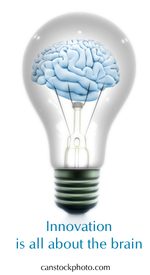Long-term success in the global economy depends on innovation that is both original and practical. Few would argue with this statement. In fact, a recent IBM poll of 1,500 CEOs identified creativity as the "most crucial factor for future success." Equally, success hinges on cultivating creative, out-of-the-box thinkers in sales, manufacturing, and leadership to prevent the company from devolving into bureaucratic mediocrity.
Yet most companies smother the creative spark, says the Harvard Business Review, because their understanding of how innovation works is rooted in false beliefs.
Science has dispelled these false beliefs, but companies have not yet caught up with the neuroscience on how the brain generates creative intelligence (CQ). As a result, most companies are failing to facilitate the creative environment that taps and expands CQ.
 Innovation is all about the brain. It's all about meeting the neurological conditions that (A) stimulate the right hemisphere of the brain to generate creative insight, (B) captures the insight quickly, and (C) transfers it to the brain's left hemisphere where it can be forged it into something revolutionary.
Innovation is all about the brain. It's all about meeting the neurological conditions that (A) stimulate the right hemisphere of the brain to generate creative insight, (B) captures the insight quickly, and (C) transfers it to the brain's left hemisphere where it can be forged it into something revolutionary.
The False Beliefs about Innovation
The great American psychologist, William James, described the creative process as "a seething caldron of ideas," and now, for the first time, science is beginning to see into the cauldron itself. We are beginning to see how creative insight is actually generated inside our brain. And what's been made clear is that our old ideas about the creative process are all wrong.
False Belief No. 1: We used to believe that people were most creative when stressed, anxious, and pressured, but a number of studies strongly suggests that stress undermines the creative cognitive processing that contribute to creative output in organizations (Forbes, 2012, Amabile, Mueller, 2002)
False Belief No. 2: There is the belief that creativity takes an intense, sustained focus, and yet research has demonstrated that intense focus is not the best approach when you need a creative solution (White, Shah, 2006). People with ADHD actually score higher on creativity tests and win more awards in art and science contests. Creativity emerges initially in a spontaneous, free-flowing, and non-linear manner. The creative person can appear to be anything but focused. Dr. Paul Torrance, the scientist who designed the cutting edge tool for measuring creative talent, found that the creative process involves exploring, questioning, experimenting, manipulating, re-arranging and incubating with creative ideas.
False Belief No. 3: We have also tended to believe that creativity means we have to put our noses to grindstone, but the experience of 3M Corporation and Google have proven that the polar opposite is true, which research has corroborated. For decades employees at 3M have been encouraged to use up to 15 percent of their regular work hours to pursue ideas of their own making, even if these ideas are outside 3M's strategic pursuits. It's called the 15-Percent Rule, and it's credited with the company's stellar innovations, including the Post-It. Google upped the 15-Percent-Rule to 20 percent, and founders Larry Page and Sergey Brin stated that Google's 20 percent rule was instrumental to the company's ability to innovate, leading to many of its most significant advances, including AdSense, which now accounts for about 25 percent of the company's annual revenue.
False Belief No. 4: There is the age old belief that says you have to suffer and struggle in order to create and yet studies have found that creativity is positively associated with inner peace, joy, empathy, and optimism, and negatively associated with stress and fear (Subramaniam, Kounios, 2009). Researchers have found that a positive mood broadens your scope and allows you to look at a problem in new ways and come up with better solutions (Fredrickson, Branigan, 2005).
False Belief No. 5: Perhaps the most limiting belief about creativity is the notion that people are either genetically gifted with creative talent or not. The capacity for creativity is built into the very structure of everyone's brain (Beeman, Bowden, 2004). It's merely that people who become highly innovative as adults had teachers, mentors, and parents who helped them cultivate creative intelligence as children (Runco, Millar, 2010). But if we missed the leg-up as a kid, we can get it as an adult. Creativity is teachable. Research shows that those who diligently practice creative activities learn to recruit their brains' creative networks quicker and better (Jung, Haier, 2008).
How Do Companies Develop Breakthrough Innovators?
The research on creativity indicates that raising creative intelligence begins with raising people's emotional intelligence, and in particular their level of happiness and inner peace. This is due in large part because processes that increase positive emotional states stimulate the right hemisphere of the brain where creative insights are generated. There are four proven approaches to elevating mood for this result, and each is actually quite simple and not difficult to learn or apply.
1. Decrease emotional negativity by teaching people how to alleviate stress, anxiety, and pessimism. This is achieved through a practice that (a) actively interrupts patterns of stress provoking thoughts and perceptions that stressed and anxious people habitually think (Robinson, Alloy, 2003), and (b) strengthens a dynamically peaceful mindset (Davidson, Kabat-Zinn,2003).
2. Elevate the capacity for positive emotional states through an active practice of gratitude, and by teaching people to visualize their "best possible self" (Sheldon, Lyubomirsky, 2006).
- Gratitude is develop through a simple practice of counting blessing in a specific manner.
- Invoking one's "best possible self" is achieved (a) by identifying qualities we experience when we perform at the top of our game at work, and when are at our best in our personal life, (b) forming these qualities into a clear mental image of who we are capable of being, and (c) making our "best possible self" our primary goal that we aspire to actualize.
3. Integrate 20-minute breaks into the work-day, at least one mid-morning and another mid-afternoon. Breaks improve memory consolidation, which is essential to envisioning something novel or learning something new (Tambini, 2013), and breaks increase unconscious associative processing that facilitates creative problem solving (Baird, Smallword, 2012).
4. Encourage people to take a 90-minute walk periodically through a natural environment. A 90-minute walk in nature has been shown to reduce the mental rumination associated with anxiety and depression. (Bratman, Daily 2015).
Last but not least, implementing the most promising creative ideas that will emerge from this new creative environment involves a methodical process, such as Treffinger's Creative Problem-Solving method (CPS). CPS helps teams move from creative insight to tangible innovation through a process that clarifies the creative problem, researches it, generates and processes ideas, turns good ideas into best solutions, and then creates a plan to bridge solutions to actions.
